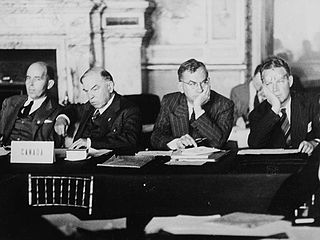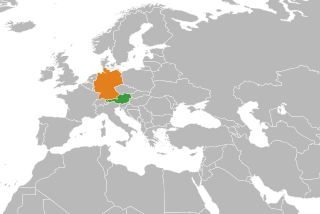
The Potsdam Agreement was the 1 August 1945 agreement between three of the Allies of World War II: the United Kingdom, the United States, and the Soviet Union. A product of the Potsdam Conference, it concerned the military occupation and reconstruction of Germany, its borders, and the entire European Theatre of War territory. It also addressed Germany's demilitarisation, reparations, the prosecution of war criminals and the mass expulsion of ethnic Germans from various parts of Europe.

The Triple Alliance was an agreement between Germany, Austria-Hungary, and Italy. It was formed on 20 May 1882 and renewed periodically until it expired in 1915 during World War I. Germany and Austria-Hungary had been closely allied since 1879. Italy was looking for support against France shortly after it lost North African ambitions to the French. Each member promised mutual support in the event of an attack by any other great power. The treaty provided that Germany and Austria-Hungary were to assist Italy if it was attacked by France without provocation. In turn, Italy would assist Germany if attacked by France. In the event of a war between Austria-Hungary and Russia, Italy promised to remain neutral. The existence and membership of the treaty were well known, but its exact provisions were kept secret until 1919.

The Treaty of Trianon was prepared at the Paris Peace Conference and was signed in the Grand Trianon Palace in Versailles on 4 June 1920. It formally ended World War I between most of the Allies of World War I and the Kingdom of Hungary. French diplomats played the major role in designing the treaty, with a mind to establishing a French-led coalition of the newly formed nations. It regulated the status of the Kingdom of Hungary and defined its borders generally within the ceasefire lines established in November–December 1918 and left Hungary as a landlocked state that included 93,073 square kilometres (35,936 sq mi), 28% of the 325,411 square kilometres (125,642 sq mi) that had constituted the pre-war Kingdom of Hungary. The truncated Kingdom had a population of 7.6 million, 36% compared to the pre-war kingdom's population of 20.9 million. Though the areas that were allocated to neighbouring countries had a majority of non-Hungarians, in them lived 3.3 million Hungarians – 31% – who were now in a minority status. The treaty limited Hungary's army to 35,000 officers and men, and the Austro-Hungarian Navy ceased to exist. These decisions and their consequences have been the cause of deep resentment in Hungary ever since.

The Paris Peace Treaties were signed on 10 February 1947 following the end of World War II in 1945. The Paris Peace Conference lasted from 29 July until 15 October 1946. The victorious wartime Allied powers negotiated the details of peace treaties with Italy, Romania, Hungary, Bulgaria and Finland. The treaties allowed the defeated Axis powers to resume their responsibilities as sovereign states in international affairs and to qualify for membership in the United Nations.

The aftermath of World War I saw drastic political, cultural, economic, and social change across Eurasia, Africa, and even in areas outside those that were directly involved. Four empires collapsed due to the war, old countries were abolished, new ones were formed, boundaries were redrawn, international organizations were established, and many new and old ideologies took a firm hold in people's minds. World War I also had the effect of bringing political transformation to most of the principal parties involved in the conflict, transforming them into electoral democracies by bringing near-universal suffrage for the first time in history, as in Germany, Great Britain, and Turkey.

The Treaty of Saint-Germain-en-Laye was signed on 10 September 1919 by the victorious Allies of World War I on the one hand and by the Republic of German-Austria on the other. Like the Treaty of Trianon with Hungary and the Treaty of Versailles with Germany, it contained the Covenant of the League of Nations and as a result was not ratified by the United States but was followed by the US–Austrian Peace Treaty of 1921.

The Treaty of Bucharest (1918) was a peace treaty between Romania and the opposing Central Powers following the stalemate reached after the campaign of 1917. This left Romania isolated after Russia's unilateral exit from World War I.
Article 231, often known as the War Guilt Clause, was the opening article of the reparations section of the Treaty of Versailles, which ended the First World War between the German Empire and the Allied and Associated Powers. The article did not use the word "guilt" but it served as a legal basis to compel Germany to pay reparations for the war.

The term France–Habsburg rivalry describes the rivalry between France and the House of Habsburg. The Habsburgs headed an expansive and evolving Empire that included, at various times, the Holy Roman Empire, the Spanish Empire and the Austro-Hungarian Empire from the Diet of Augsburg in the High Middle Ages until the dissolution of the monarchy following the World War I in the Late modern period.

The Republic of German-Austria was a country created following World War I as the initial rump state for areas with a predominantly German-speaking and ethnic German population within what had been the Austro-Hungarian Empire. The territories covered an area of 118,311 km2 (45,680 sq mi), with 10.4 million inhabitants. In practice, however, its authority was limited to the Danubian and Alpine provinces which had been the core of the Austrian Empire.

Yugoslavia was a state concept among the South Slavic intelligentsia and later popular masses from the 19th to early 20th centuries that culminated in its realization after the 1918 collapse of Austria-Hungary at the end of World War I and the formation of the Kingdom of Serbs, Croats and Slovenes. However, the kingdom was better known colloquially as Yugoslavia ; in 1929 it was formally renamed the "Kingdom of Yugoslavia".

Relations between Austria and Germany are close, due to their shared history and language, with German being the official language of both countries.
An agreement signed between the Allied Powers of the First World War on September 10, 1919. The agreement was registered in the League of Nations Treaty Series on 21 October 1920.
The U.S.–Austrian Peace Treaty is a peace treaty between the United States and Austria, signed in Vienna on August 24, 1921, in the aftermath of the First World War. This separate peace treaty was required because the United States Senate refused to advise and consent to the ratification of the multilateral Treaty of Saint-Germain-en-Laye of 1919.
The U.S.–German Peace Treaty was a peace treaty between the U.S. and the German governments. It was signed in Berlin on August 25, 1921 in the aftermath of World War I. The main reason for the conclusion of that treaty was the fact that the U.S. Senate did not consent to ratification of the multilateral peace treaty signed in Versailles, thus leading to a separate peace treaty. Ratifications were exchanged in Berlin on November 11, 1921, and the treaty became effective on the same day. The treaty was registered in League of Nations Treaty Series on August 12, 1922.
The U.S.–Hungarian Peace Treaty is a peace treaty between the United States and the Kingdom of Hungary, signed in Budapest on August 29, 1921, in the aftermath of the First World War. This separate peace treaty was required because the United States Senate refused to ratify the multilateral Treaty of Trianon.
The United Kingdom declared war on Germany on 3 September 1939, two days after Germany invaded Poland. France also declared war on Germany later the same day.
The Austro-Slovene conflict in Carinthia was a military engagement that ensued in the aftermath of World War I between forces loyal to the State of Slovenes, Croats and Serbs and later the Kingdom of Serbs, Croats and Slovenes, and forces loyal to the Republic of German-Austria. The main theater of the conflict was the linguistically mixed region in southeastern Carinthia. The conflict was settled by the Treaty of Saint-Germain in 1919, which stipulated that the territorial dispute be resolved by a plebiscite.
The dissolution of Austria-Hungary was a major geopolitical event that occurred as a result of the growth of internal social contradictions and the separation of different parts of Austria-Hungary. The reason for the collapse of the state was World War I, the 1918 crop failure and the economic crisis. The 1917 October Revolution and the Wilsonian peace pronouncements from January 1918 onward encouraged socialism on the one hand, and nationalism on the other, or alternatively a combination of both tendencies, among all peoples of the Habsburg monarchy.

The Armistice of Belgrade was signed on 13 November 1918 between the First Hungarian Republic of Mihály Károlyi and the Allied Powers in Belgrade. It was later not respected by the allies, which led to the collapse of the First Hungarian Republic and its replacement by the Hungarian Soviet Republic in March 1919.